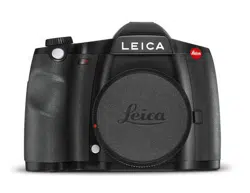Loading ...
Loading ...
Loading ...

EN
6
General information
GENERAL INFORMATION
CAMERA/LENS
• Make a note of the serial numbers of your camera (engraved in the
base of the camera housing) and lenses, as this information will be
extremely important in case of loss.
• Make sure to always have a lens or the camera bayonet cover attached
to prevent dust or other foreign bodies penetrating the camera.
• That is why you should always replace lenses quickly and in a dust-free
environment.
• Never store the camera bayonet cover or the lens back cover in a
pants pocket, as they will attract lint and dust, which could then be
accidentally introduced into the camera.
• Leica releases firmware updates for lenses at irregular intervals. You
can download any new firmware version from our homepage and
transfer it to your lens. Please read the section “Installing firmware” (p.
61) for more information.
LCD PANEL
• Condensation may form on the LCD panel if the camera is exposed to
great temperature fluctuations. Wipe the screen carefully with a soft,
dry cloth.
• The screen image will initially be slightly darker than normal if the
camera is very cold when it is switched on. The normal level of
brightness will be reached as soon as the LCD panel warms up.
RECHARGEABLE BATTERY
• The battery must have a temperature between +10°C and+ 30°C for
charging, as the charger will otherwise not switch on or will switch off
again.
• Lithium-ion batteries can be charged at any time, regardless of their
current charge level. A partially charged battery will charge to full
capacity faster than a fully discharged one.
• The rechargeable batteries come only partly charged ex works and
should therefore be charged fully before their first use.
• A new battery only reaches its full capacity after it has been fully
charged and – by using it in the camera – depleted 2 to 3 times. This
depletion process should be repeated roughly every 25 cycles.
• Battery and charger heat up during the charging process. That is
normal and not a malfunction.
• Rapid flashing of the two LEDs (>2Hz) when charging commences
indicates a charging error (e.g. maximum charging time exceeded,
voltages or temperatures outside permitted ranges or a short circuit).
Disconnect the charger from the mains and remove the battery. Ensure
that the above temperature conditions are met and then restart the
charging process. Please contact your dealer, the Leica office in your
country or Leica Camera AG if the problem persists.
• Rechargeable lithium-ion batteries generate power by way of internal
chemical reactions. These reactions are influenced by ambient
temperature and humidity. To ensure a maximum service life of the
battery, it should not be exposed to extreme temperatures (high or
low) for extended periods of time (e.g. in a parked car in the summer
or winter).
• However, every battery has a limited service life! After several hundred
charging cycles, this limitation will become evident as the operating
times get significantly shorter.
• The replaceable battery supplies power to a backup battery, which is
permanently installed in the camera. This backup battery retains the
date and time for some weeks. Once the backup battery is depleted, it
must be replenished by inserting a charged main battery. The time and
date will have to be set again after a full depletion of both batteries.
• As the battery capacity deteriorates or if using an older battery,
warning messages may appear and some functions may be restricted
or blocked entirely.
• Remove the battery if the camera will not be used for an extended
period of time. Make sure to switch the camera off via the main switch
before removing the battery. Leaving the battery in the camera will
result in a deep discharge after a few weeks. Voltage levels will
decrease significantly, as the camera uses a low idle current to
maintain settings.
• Dispose of damaged batteries in accordance with the relevant
regulations at an approved collection point for proper recycling.
• The date of manufacture can be found on the battery.
The date format is week/year.
MEMORY CARD
• The range of available SD/SDHC/SDXC cards on the market is too
extensive for Leica Camera AG to test for compatibility and quality.
Generally, any type of memory card may be used without any damage
to the camera or memory card. As some "no name" cards may not fully
comply with the SD/SDHC/SDXC standards, Leica Camera AG cannot
provide any guarantee of function.
• We recommend formatting memory cards from time to time, because
fragmented residual data from deleted files may block some of the
storage capacity.
• Generally, it is not necessary to format (initialize) memory cards that
have been previously used. Formatting will, however, be necessary if
you insert an unformatted memory card or a card that was formatted
in another device (e.g. a computer) for the first time.
• We recommend backing up your data on a PC, because electromag-
netic fields, static electricity and any memory card or camera defects
could result in permanent damage or loss of your data.
• SD, SDHC, and SDXC memory cards come with a write protection
slider to prevent accidental overwriting. This slider is located on the
non-beveled side of the card. All data on the card is protected when
the slider is set to its lower position, marked LOCK.
SENSOR
• Any dust or dirt particles stuck to the glass cover of the sensor may
result in noticeable dark stains or specks on the pictures.
DATA
• All data, including personal information, may be changed or deleted
due to incorrect or accidental operation, static discharge, accidents,
malfunctions, repairs and other measures.
• Please note that Leica Camera AG does accept liability for direct or
consequential damage due to the manipulation or destruction of data
and personal information.
Loading ...
Loading ...
Loading ...
